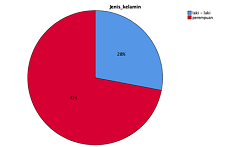Pelatihan Kardiovaskular untuk Kalangan Non-Medis dengan Media Daring di Era Pandemi Covid-19 Cardiovascular Training for Public with Online Media in the Covid-19 Pandemic Era
Main Article Content
Abstract
Health literacy is one of the essential components of the health sector. Health literacy could diminish mortality and morbidity, especially in cardiovascular disease. Until now, coronary artery disease is one of the most threatening diseases in our society. Pandemic forces our world to change into a digital era, including in health education. Surprisingly, online education is increasing health literacy as effectively as the conventional method. This study aims to determine the effect of a training program on knowledge of non-medical society about heart and blood vessel disease. This research was comparing pre-test and post-test scores for non-medical societies in webinars about coronary artery disease. From our result, we found that online education could increase the scope of the participant (48% of participants come from outside Jakarta). Our participants also quite vary from youngsters to senior citizens, from 18 to 69 years old. The online webinar could increase health literacy in coronary artery disease significantly (pre-test score: 50 (10-100), post-test score: 60 (20-100), p-value <0.001). Webinars about coronary artery disease could increase health literacy in non-medical society and it seems to be an effective method during pandemic COVID-19.
Downloads
Article Details
Authors who publish with this journal agree to the following terms:
- Any article on the copyright is retained by the author(s).
- Author grant the journal, right of first publication with the work simultaneously licensed under a Creative Commons Attribution License that allows others to share work with acknowledgment of the work authors and initial publications in this journal.
- Authors are able to enter into a separate, additional contractual arrangements for non-exclusive distribution of published articles of work (eg, post-institutional repository) or publish it in a book, with acknowledgment of its initial publication in this journal.
- Authors are permitted and encouraged to post their work online (e.g., in institutional repositories or on their websites) prior to and during the submission process, as can lead to productive exchanges, as well as earlier and greater citation of published work.
- The article and any associated published material is distributed under the Creative Commons Attribution-ShareAlike 4.0 International License
References
Baker, D., Gazmararian, J., Sudano, J., Patterson, M. 2000. The Association Between Age and Health Literacy Among Elderly Persons. The Journals of Gerontology Series B: Psychological Sciences and Social Sciences. 55(6):S368-S374. https://doi.org/10.1093/geronb/55.6.S368
Brørs, G., Norman, C., Norekvål, T. 2020. Accelerated importance of eHealth literacy in the COVID-19 outbreak and beyond. European Journal of Cardiovascular Nursing. 19(6):458-461. https://doi.org/10.1177/1474515120941307
Dhawan, S. 2020. Online Learning: A Panacea in the Time of COVID-19 Crisis. Journal of Educational Technology Systems. 49(1):5-22. https://doi.org/10.1177/0047239520934018
Laksono, S., Setianto, B., Surya, S.P. 2020. Angiotensin converting enzyme 2 (ACE2), COVID-19 and cardiac injury: what cardiologist should know. Journal of The Medical Sciences (Berkala Ilmu Kedokteran), 52(3):105-110. https://doi.org/10.19106/JMedSciSI005203202009
Magnani, J., Mujahid, M., Aronow, H., Cené, C., Dickson, V., Havranek, E. et al. 2018. Health Literacy and Cardiovascular Disease: Fundamental Relevance to Primary and Secondary Prevention: A Scientific Statement from the American Heart Association. Circulation. 138(2):e48-e74. https://doi.org/10.1161/cir.0000000000000579
Nazar, M., Khan, S., Kumar, R., Hafeez, A. 2019. Effectiveness of health literacy intervention on cardiovascular diseases among university students of Pakistan. BMC Health Services Research. 19(1):504. https://doi.org/10.1186/s12913-019-4348-y
Ortega-Navas, M. 2017. The use of New Technologies as a Tool for the Promotion of Health Education. Procedia - Social and Behavioral Sciences. 237:23-29. https://doi.org/10.1016/j.sbspro.2017.02.006
Palumbo, R. 2017. Examining the impacts of health literacy on healthcare costs. An evidence synthesis. Health Services Management Research. 30(4):197-212. https://doi.org/10.1177/0951484817733366
Purwowiyoto, S.L., Purwowiyoto, B.S. 2020. Break the chain of COVID-19 transmission: Cardiologist Perspective. Indonesian Journal of Cardiology. 41(2):46-48. https://doi.org/10.30701/ijc.1000
Tschaftary, A., Hess, N., Hiltner, S., Oertelt-Prigione, S. 2018. The association between sex, age and health literacy and the uptake of cardiovascular prevention: a cross-sectional analysis in a primary care setting. Journal of Public Health. 26(5):551-558. https://doi.org/10.1007/s10389-017-0888-y
